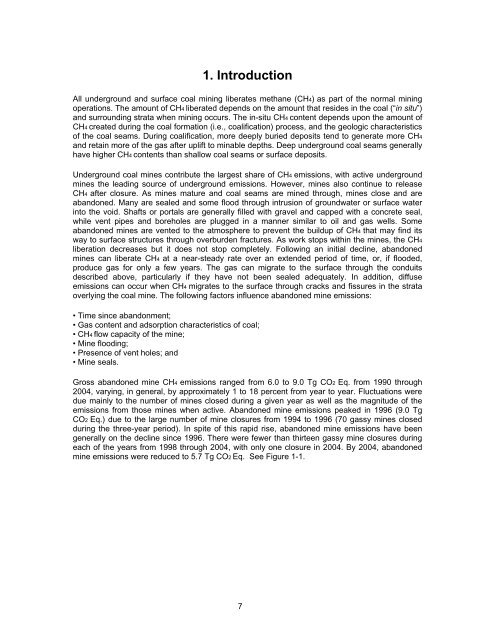U.S. Abandoned Coal Mine Methane Recovery Project Opportunities
U.S. Abandoned Coal Mine Methane Recovery Project Opportunities
U.S. Abandoned Coal Mine Methane Recovery Project Opportunities
Create successful ePaper yourself
Turn your PDF publications into a flip-book with our unique Google optimized e-Paper software.
1. Introduction<br />
All underground and surface coal mining liberates methane (CH4) as part of the normal mining<br />
operations. The amount of CH4 liberated depends on the amount that resides in the coal (“in situ”)<br />
and surrounding strata when mining occurs. The in-situ CH4 content depends upon the amount of<br />
CH4 created during the coal formation (i.e., coalification) process, and the geologic characteristics<br />
of the coal seams. During coalification, more deeply buried deposits tend to generate more CH4<br />
and retain more of the gas after uplift to minable depths. Deep underground coal seams generally<br />
have higher CH4 contents than shallow coal seams or surface deposits.<br />
Underground coal mines contribute the largest share of CH4 emissions, with active underground<br />
mines the leading source of underground emissions. However, mines also continue to release<br />
CH4 after closure. As mines mature and coal seams are mined through, mines close and are<br />
abandoned. Many are sealed and some flood through intrusion of groundwater or surface water<br />
into the void. Shafts or portals are generally filled with gravel and capped with a concrete seal,<br />
while vent pipes and boreholes are plugged in a manner similar to oil and gas wells. Some<br />
abandoned mines are vented to the atmosphere to prevent the buildup of CH4 that may find its<br />
way to surface structures through overburden fractures. As work stops within the mines, the CH4<br />
liberation decreases but it does not stop completely. Following an initial decline, abandoned<br />
mines can liberate CH4 at a near-steady rate over an extended period of time, or, if flooded,<br />
produce gas for only a few years. The gas can migrate to the surface through the conduits<br />
described above, particularly if they have not been sealed adequately. In addition, diffuse<br />
emissions can occur when CH4 migrates to the surface through cracks and fissures in the strata<br />
overlying the coal mine. The following factors influence abandoned mine emissions:<br />
• Time since abandonment;<br />
• Gas content and adsorption characteristics of coal;<br />
• CH4 flow capacity of the mine;<br />
• <strong>Mine</strong> flooding;<br />
• Presence of vent holes; and<br />
• <strong>Mine</strong> seals.<br />
Gross abandoned mine CH4 emissions ranged from 6.0 to 9.0 Tg CO2 Eq. from 1990 through<br />
2004, varying, in general, by approximately 1 to 18 percent from year to year. Fluctuations were<br />
due mainly to the number of mines closed during a given year as well as the magnitude of the<br />
emissions from those mines when active. <strong>Abandoned</strong> mine emissions peaked in 1996 (9.0 Tg<br />
CO2 Eq.) due to the large number of mine closures from 1994 to 1996 (70 gassy mines closed<br />
during the three-year period). In spite of this rapid rise, abandoned mine emissions have been<br />
generally on the decline since 1996. There were fewer than thirteen gassy mine closures during<br />
each of the years from 1998 through 2004, with only one closure in 2004. By 2004, abandoned<br />
mine emissions were reduced to 5.7 Tg CO2 Eq. See Figure 1-1.<br />
7

















